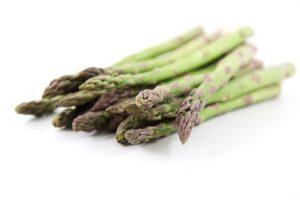High-quality Hungarian asparagus is a sought-after product on both domestic and export markets
There is a huge demand for high-quality Hungarian asparagus on both domestic and export markets. Although the overall production area is showing a decreasing trend, the quantity produced for export is increasing year by year. According to the joint overview of the National Chamber of Agriculture (NAK) and the Hungarian Vegetable and Fruit Interprofessional Organization (FuritVeB), the season started this year at the usual time, in mid-April.

(Photo: Pixabay)
In line with the long-term average, the domestic asparagus season started this year in mid-April, with the first pickings starting around Easter on the plantations. According to the joint overview of the National Chamber of Agriculture (NAK) and the Hungarian Vegetable and Fruit Interprofessional Organization (FuritVeB), the asparagus production area has decreased significantly in the past decade, barely exceeding 1,000 hectares in 2023. Accordingly, the harvested quantity of asparagus also decreased, reaching 3.7 thousand tons in 2024. The reason for the negative trend is primarily that asparagus is an extremely manual labor-intensive crop, so in recent years more and more people have reduced their asparagus-growing area, because the quality and quantity problems experienced in terms of labor force cause enormous difficulties during the harvest. The problem of labor shortage – especially in the case of smaller producers – seems insoluble, and considering the future of production, affordable mechanization can give hope to farmers.
Asparagus production is mainly characteristic of the Homokhátság region
Our largest production areas are located in Bács-Kiskun and Csongrád counties, in addition, Hajdú-Bihar and Békés counties are engaged in even more significant asparagus production. The dominant part of domestic asparagus production is made up of 4-5 larger producers, who basically supply the export markets and sell a smaller part of their asparagus to domestic supermarket chains. In addition, smaller producers are also involved in asparagus production, who mainly sell on the domestic market. There is a huge demand for high-quality Hungarian asparagus on both the domestic and export markets. Accordingly, despite the decreasing production area, the amount of asparagus produced for export is increasing: while in previous years we exported almost half of the harvested asparagus, in 2024 we sold three-quarters of the crop on foreign markets.
Asparagus can be classified into four types according to the color of the shoots: white, purple, purple-green and green
If it is picked when it has not yet emerged from the ground, its color is still white, but when it has already emerged, it turns purple under the influence of sunlight. Green asparagus is harvested when the entire shoot is above the ground and the sunlight has painted it a bright green. It grows best in loose, sandy, humus-rich soil, where it is easiest to harvest its juicy shoots. Fresh asparagus is available from April to the end of June, while canned asparagus is available all year round. The demand for asparagus is showing an increasing trend both in the European Union and in Hungary, which is due, among other things, to health trends and consumer awareness. Due to the growing attention to health and well-being, consumers are looking for low-calorie, high-fiber and antioxidant-rich foods such as asparagus. Consumers are increasingly aware of the nutritional benefits of asparagus, including its vitamin and mineral content, which contributes to its popularity. At the same time, while previously the customer could almost exclusively encounter fresh asparagus in stores, with the increasing demand for convenience and processed products, more and more canned and frozen asparagus products are now being placed on the shelves, but the demand for pickled and pickled asparagus is also increasing. Consumers are increasingly interested in sliced, washed and ready-to-cook asparagus formats, reflecting the growing demand for convenient food preparation.
Asparagus is a real vitamin bomb
The sprout is rich in vitamins A, B1, B2, B3, B5, B6, B7, C, E, K, folic acid, as well as calcium, phosphorus, iron, sodium, potassium, silicon and molybdenum. It also contains many valuable amino acids, including aspartic acid. The most delicious part of the asparagus sprout is the head, it is the softest and tastiest. The lower part of the stem is more fibrous, the outer fibers can be slightly bitter. Fresh asparagus can be stored in the refrigerator for 2-3 days wrapped in a damp kitchen towel, but it is advisable to prepare it fresh, as it is most delicious that way
Related news
This year, 10 percent more new wine was produced than last year
🎧 Hallgasd a cikket: Lejátszás Szünet Folytatás Leállítás Nyelv: Auto…
Read more >AM: Government helps farmers with a loan moratorium
🎧 Hallgasd a cikket: Lejátszás Szünet Folytatás Leállítás Nyelv: Auto…
Read more >More than 100 Hungarian farmers also demonstrated in Brussels
🎧 Hallgasd a cikket: Lejátszás Szünet Folytatás Leállítás Nyelv: Auto…
Read more >Related news
The New Year’s Eve fireworks fair is back: temporary sales will start in department store parking lots at the end of December
🎧 Hallgasd a cikket: Lejátszás Szünet Folytatás Leállítás Nyelv: Auto…
Read more >The first Eastern European non-alcoholic beer turns 50
🎧 Hallgasd a cikket: Lejátszás Szünet Folytatás Leállítás Nyelv: Auto…
Read more >Sausage: pork prices are already going down, but they won’t be cheaper in stores – a significant correction may come in the spring at the earliest
🎧 Hallgasd a cikket: Lejátszás Szünet Folytatás Leállítás Nyelv: Auto…
Read more >






